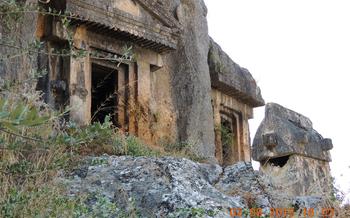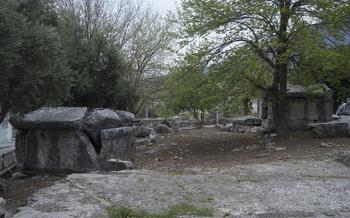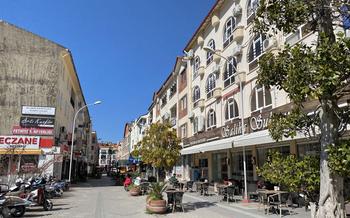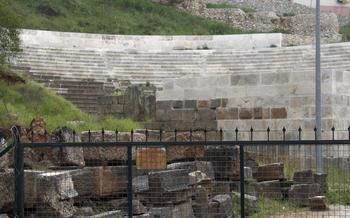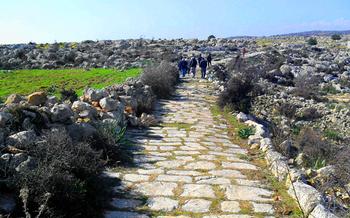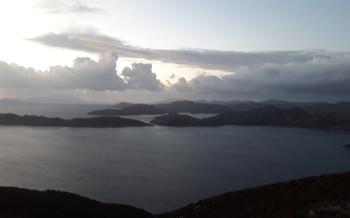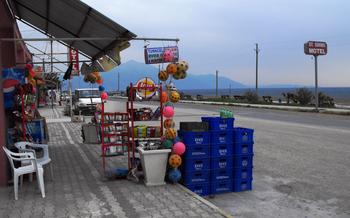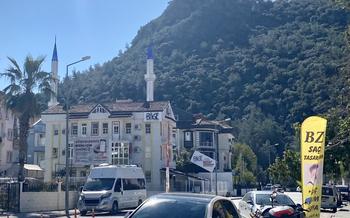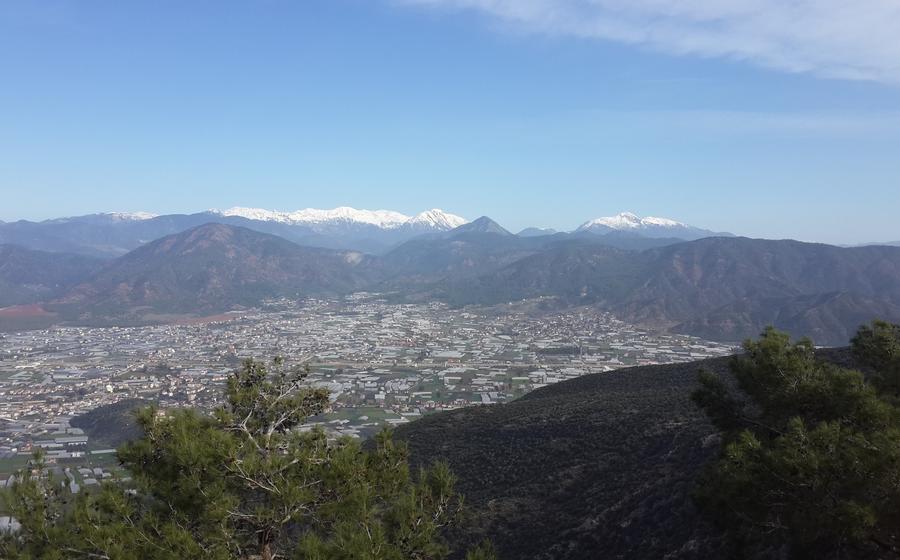
Fethiye Aqueduct
- The Fethiye Aqueduct: A Timeless Masterpiece
- Location and Accessibility
- Historical Background
- Architectural Marvel
- Dimensions and Statistics
- Preservation and Restoration
- Visiting the Aqueduct
- Exploring the Surrounding Area
- The Aqueduct at Night
- The Aqueduct's Legacy
- Unveiling the Ancient City
- The Aqueduct as a Landmark
- Interactive Experiences
- Insider Tip: Hidden Gem
The Fethiye Aqueduct: A Timeless Masterpiece
The Fethiye Aqueduct stands as a testament to the ingenuity and engineering prowess of ancient civilizations. Constructed in the 3rd century AD during the Roman period, it served as a vital water supply system for the city of Fethiye, then known as Telmessos. This architectural marvel has endured the test of time, showcasing the remarkable skill and precision of its builders.
The aqueduct's design features a series of arched structures that gracefully carry water over a distance of approximately 4 kilometers. The intricate stonework and buttresses provide stability and strength, allowing the structure to withstand centuries of wear and tear. The aqueduct's significance extends beyond its practical function as a water source; it stands as a symbol of Fethiye's rich history and cultural heritage.
Location and Accessibility
The Fethiye Aqueduct stands as a majestic testament to ancient engineering in the heart of Fethiye, Turkey. To reach this architectural marvel, make your way to Cumhuriyet Mahallesi, where it proudly stands near the city center. The exact address is Cumhuriyet Mahallesi, 48300 Fethiye/Muğla.
For those relying on public transportation, the Fethiye Aqueduct is conveniently accessible by local buses. Several bus lines stop within walking distance of the aqueduct, providing a hassle-free journey. Once you arrive in Fethiye, simply inquire about the bus routes that pass near the aqueduct, and you'll be on your way to witnessing this ancient wonder.
For those who prefer the convenience of driving, there are ample parking options available near the aqueduct. Designated parking areas are located within a short walking distance, ensuring a smooth and stress-free visit. Whether you choose to explore the aqueduct on foot or by car, its central location makes it easily accessible to visitors from all corners of Fethiye.
Historical Background
The Fethiye Aqueduct, a testament to ancient engineering brilliance, was constructed during the Roman period, likely in the 2nd or 3rd century AD. Its primary purpose was to provide a steady supply of water to the city of Fethiye, then known as Telmessos. The aqueduct formed an integral part of the city's infrastructure, ensuring a reliable source of water for daily life, irrigation, and public fountains.
Fethiye, strategically situated on the Mediterranean coast, flourished as a significant port city in ancient times. The construction of the aqueduct reflects the city's prosperity and the importance placed on water management. Ancient water systems in Fethiye were remarkably advanced, utilizing techniques such as underground channels, reservoirs, and aqueducts to distribute water throughout the city.
The aqueduct's construction marked a turning point in Fethiye's development. The reliable water supply it provided supported population growth, agricultural expansion, and economic prosperity. It became a symbol of the city's engineering prowess and resilience, standing as a testament to the ingenuity of ancient civilizations.
Architectural Marvel
The Fethiye Aqueduct is a testament to ancient engineering brilliance and architectural prowess. It features a series of elegant arches that rise up to support the water channel, creating a visually striking structure. The arches are not merely decorative but serve a crucial structural purpose, distributing the weight of the water evenly and ensuring stability.
The aqueduct is constructed from local stone, which has weathered over time to acquire a warm, honey-colored patina. The builders employed advanced construction techniques for its era, using interlocking blocks and mortar to create a durable and long-lasting structure. The aqueduct's design incorporates buttresses, which are reinforcing structures that help to withstand lateral forces such as wind and earthquakes.
The Fethiye Aqueduct stands out even when compared to other ancient aqueducts around the world. Its unique combination of arched structure, buttresses, and local stone construction sets it apart as a remarkable example of ancient engineering.
Dimensions and Statistics
The Fethiye Aqueduct stands as a testament to ancient engineering prowess, boasting impressive dimensions that speak to its grandeur. Stretching approximately 300 meters in length, it reaches a remarkable height of 10 meters, allowing water to flow effortlessly across the landscape. Its width, spanning a distance of 5 meters, further accentuates its imposing presence.
The aqueduct's most striking feature is its series of arches, numbering 112 in total. These arches, each measuring approximately 2 meters in width, not only provide structural support but also create a visually stunning rhythm that draws the eye along the length of the aqueduct. The arches, constructed with precision and symmetry, demonstrate the skill and artistry of the ancient builders.
The aqueduct's engineering efficiency is evident in its ability to transport large quantities of water over long distances. Its impressive water flow capacity, estimated at around 200 liters per second, ensured a reliable water supply for the city of Fethiye. This remarkable feat of engineering highlights the ingenuity of the ancient water management systems that sustained thriving communities in the region.
Preservation and Restoration
The Fethiye Aqueduct, a testament to ancient engineering prowess, has withstood the test of time and remains a symbol of Fethiye's rich history. However, the relentless march of time and various environmental factors have taken their toll on this architectural marvel, necessitating ongoing preservation and restoration efforts.
Conservationists and historians face the challenge of balancing the need to preserve the aqueduct's authenticity while ensuring its structural integrity and accessibility to visitors. Past restoration projects have focused on repairing damaged sections, reinforcing weakened arches, and implementing measures to prevent further deterioration.
One of the most significant restoration projects was undertaken in the early 20th century, when the aqueduct underwent extensive repairs and reinforcement. This intervention involved strengthening the foundations, rebuilding collapsed arches, and clearing away vegetation that had accumulated over time. The project successfully restored the aqueduct to its former glory, ensuring its survival for future generations.
Today, ongoing maintenance and protection measures are in place to safeguard the aqueduct. Regular inspections are conducted to identify any potential structural issues, and preventive measures are taken to mitigate the impact of environmental factors such as erosion and seismic activity. By proactively addressing these challenges, the Fethiye Aqueduct can continue to stand as a symbol of resilience and a testament to the enduring legacy of ancient engineering.
Visiting the Aqueduct
The best time to visit the Fethiye Aqueduct is during the early morning or late afternoon when the sunlight casts a golden glow on its ancient stones. The soft lighting enhances the aqueduct's grandeur and creates a picturesque setting for capturing stunning photographs. Weather conditions also play a crucial role in elevating the experience. A clear blue sky provides a vibrant backdrop for the aqueduct, while a light mist or drizzle can add an atmospheric touch to your visit.
Guided tours are available for those who seek a deeper understanding of the aqueduct's history and significance. Knowledgeable guides provide insights into the engineering prowess of the ancient builders and share intriguing stories about the aqueduct's role in Fethiye's development. These tours offer an immersive experience that brings the past to life.
When photographing the aqueduct, consider experimenting with different angles and perspectives to capture its grandeur. Step back to take in the entire structure, or zoom in on intricate details like the arches and buttresses. Play with light and shadow to create dramatic effects, and don't forget to capture the aqueduct against the backdrop of the surrounding landscape.
Exploring the Surrounding Area
Beyond the historical significance of the Fethiye Aqueduct, the surrounding area offers a treasure trove of attractions waiting to be explored. Just a short stroll away, visitors can immerse themselves in the rich history and culture of Fethiye at its local museums and historical sites. These venues provide a deeper understanding of the region's past, offering insights into the lives of its ancient inhabitants and their contributions to the modern world.
For those seeking a bustling atmosphere, the vibrant local markets are a must-visit. From traditional Turkish handicrafts and textiles to fresh produce and local delicacies, these markets offer a sensory feast for visitors. Haggling is not only expected but also encouraged, making the shopping experience an interactive and enjoyable cultural exchange.
And when it comes to culinary delights, Fethiye doesn't disappoint. From traditional Turkish cuisine to international fare, there are options to suit every palate. Indulge in the aromatic flavors of freshly grilled kebabs, savor the creamy delight of Turkish delight, or sip on a refreshing glass of çay (Turkish tea) while soaking in the lively atmosphere of local cafes.
The Aqueduct at Night
As the sun sets and dusk casts a warm glow over Fethiye, the aqueduct transforms into a magical spectacle. The ancient structure takes on a new aura, its arches and buttresses casting long shadows across the surrounding landscape. The strategic placement of lighting illuminates the aqueduct's intricate details, highlighting its architectural prowess.
During summer evenings, special events and light shows bring the aqueduct to life. These displays showcase the aqueduct's grandeur through captivating visual narratives that tell the story of its history and significance. The fusion of light, sound, and music creates an immersive experience that transports visitors back in time.
For those seeking a serene moment, a stroll around the aqueduct at night offers a sense of tranquility. The gentle hum of the city fades away, allowing visitors to connect with the aqueduct's timeless presence. The stars twinkle above, creating a breathtaking backdrop for this ancient marvel.
Whether you're a history buff, an architecture enthusiast, or simply a seeker of beauty, the Fethiye Aqueduct at night is a must-see experience. Its nocturnal allure unveils a different side of this iconic landmark, one that is both captivating and awe-inspiring. So, as darkness falls, make sure to wander towards the aqueduct and witness its transformation into a nocturnal masterpiece.
The Aqueduct's Legacy
The Fethiye Aqueduct stands as a testament to ancient engineering prowess and continues to influence modern water infrastructure. Its design principles have inspired contemporary water management systems, emphasizing gravity-fed distribution and efficient water flow. The aqueduct's longevity and effectiveness have made it a model for sustainable water supply, demonstrating the enduring value of ancient engineering wisdom.
Beyond its practical significance, the aqueduct holds symbolic and cultural importance. It represents Fethiye's rich history, resilience, and connection to its ancient past. The aqueduct's enduring presence has fostered a sense of pride among locals and visitors alike, becoming an iconic symbol of the city.
Furthermore, the aqueduct has served as a source of inspiration for contemporary art and architecture. Artists and architects have drawn upon its unique design and historical significance to create modern works that pay homage to the aqueduct's legacy. This artistic interpretation keeps the aqueduct's spirit alive, ensuring its continued relevance in contemporary culture.
Unveiling the Ancient City
Beneath the imposing arches of the Fethiye Aqueduct lies a treasure trove of ancient history, waiting to be unearthed. Archaeological excavations in the surrounding area have uncovered a wealth of artifacts and ruins, shedding light on Fethiye's rich and storied past. From ancient pottery shards to remnants of buildings and fortifications, each discovery offers a glimpse into the lives of the people who once called this city home.
One of the most significant finds was a series of underground tunnels and chambers, believed to be part of an intricate water distribution system that supplied the city with fresh water from the nearby mountains. These tunnels, some of which are still accessible today, showcase the ingenuity and engineering prowess of the ancient builders.
As excavations continue, archaeologists are uncovering more and more evidence of Fethiye's ancient past. From remnants of temples and theaters to residential areas and marketplaces, the city's rich history is slowly being revealed. Each discovery brings us closer to understanding the lives and culture of the people who shaped this vibrant and historic city.
The Aqueduct as a Landmark
Amidst the vibrant tapestry of Fethiye's cityscape, the aqueduct stands as an enduring symbol of resilience and longevity. Its imposing presence dominates the skyline, a testament to the ingenuity and architectural prowess of ancient civilizations. The aqueduct has become inextricably linked with the identity of Fethiye, serving as a beacon of the city's rich history and cultural heritage.
For centuries, the aqueduct has withstood the ravages of time, natural disasters, and human intervention. Its sturdy construction and meticulous engineering have allowed it to endure as a remarkable relic of the past. The aqueduct's resilience serves as a reminder of the enduring spirit of Fethiye and its people, who have faced numerous challenges throughout history but have always emerged stronger.
As a prominent landmark, the aqueduct attracts countless visitors and history enthusiasts from around the world. Its grandeur and historical significance make it a must-see destination for anyone seeking to delve into the heart of Fethiye's past. Whether viewed from afar or explored up close, the aqueduct never fails to captivate and inspire awe in all who behold it.
Interactive Experiences
Enhance your visit to the Fethiye Aqueduct with a range of interactive experiences that bring history to life. Embark on a virtual reality tour to immerse yourself in the ancient world, witnessing the construction of the aqueduct and experiencing its grandeur from a unique perspective. Utilize augmented reality apps to unveil hidden layers of history, revealing forgotten details and showcasing the aqueduct's original appearance. Engage with interactive exhibits that allow you to touch, feel, and learn about the materials, techniques, and engineering principles that went into its construction. These interactive elements transform the aqueduct into a living, breathing monument, providing a deeper understanding and appreciation for this remarkable feat of ancient engineering.
Insider Tip: Hidden Gem
Beyond the main tourist routes, Fethiye holds secret treasures waiting to be discovered. For an exclusive perspective of the aqueduct, venture off the beaten path to a hidden viewpoint. This secluded spot offers a breathtaking panorama of the ancient structure, framed by lush greenery and the sparkling waters of the Mediterranean Sea. As you gaze upon the aqueduct from this unique vantage point, you'll gain a newfound appreciation for its grandeur and the ingenuity of its ancient builders.
After immersing yourself in the history and beauty of the aqueduct, continue your exploration of Fethiye's hidden gems. Discover lesser-known historical sites tucked away in the city's charming backstreets, where you can uncover forgotten stories and glimpse into the rich tapestry of Fethiye's past. Explore local markets, where vendors display an array of traditional Turkish handicrafts, spices, and delicacies. Indulge in the culinary delights of the region, savoring authentic dishes prepared with fresh, local ingredients.
As you delve deeper into Fethiye's hidden corners, you'll uncover the city's true essence and gain a profound appreciation for its unique blend of history, culture, and natural beauty. Embrace the spirit of discovery and let Fethiye reveal its secrets to you, creating memories that will last a lifetime.
